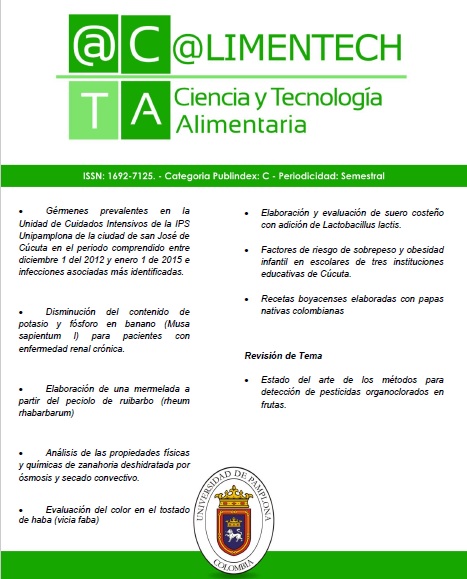Color evaluation in roasted broad beans (VICIA FABA).
DOI:
https://doi.org/10.24054/limentech.v14i2.830Keywords:
color, coffee substitute, broad bean (Vicia faba), ground roastedAbstract
Color is an important attribute in foods that influences their sensory acceptance, identifying variabilities between products, detecting defects and anomalies; in the case of substitute coffee, color is decisive in product acceptance, hoping it is as similar as possible to coffee (Coffea). The objective of this work was to evaluate the color of roasted broad beans (Vicia faba) as a possible ingredient in the preparation of a substitute coffee. Once roasted (120 ±1 ° C / 30 minutes) of 1 kg of broad beans (Vicia faba) and 1 kg of green coffee variety Colombia from Toledo Norte de Santander, with an average granulometry, NTC 3534, were carried out. 5 treatments were carried out, mixing different concentrations of ground roasted broad beans (Vicia faba) at 5%, 10%, 15% and 100% and ground roasted coffee (standard) 100%. Color was evaluated using the CIELAB color space, in triplicate. Data were analyzed using analysis of variance (ANOVA) with a 95% confidence level to determine whether there were statistically significant differences between treatments. Roasted broad bean (Vicia faba) had a dull brown hue with an *L value of 34.75, a* value of 8.23, and b* value of 18.83. The concentrations of roasted broad bean (Vicia faba) mixtures evaluated influenced the color of the substitute coffee, with statistically significant differences in color being observed between the means of the 5 treatments.
Downloads
References
Abu-Reidah, I. M., Arráez-Román, D., Warad, I., Fernández-Gutiérrez, A., &Segura-Carretero, A. (2017). UHPLC/MS 2-based approach for the comprehensive metabolite profiling of bean (Vicia fabaL.) by-products: A promising source of bioactive constituents. Food Research International, 93, 87-96.
Adams A., Borrelli R.C., Fogliano V. And De Kimpe N. (2005).Thermal Degradtion studies of Food Melanoidins. J: Agric. Food Chem. 53, 4136-4142.
Aspiazu, K., Navarro, J., Y Mendoza, O. (2012). Proyecto de comercialización del café de Haba (Vicia faba)(café orgánico), actuando como intermediario, para el consumo local en la ciudad de Guayaquil y como una opción de exportación.Facultad de Economía y Negocios, Escuela Superior Politécnica del Litoral.
Bascur Gabriel. (1997). Adaptación de la Variedad deHaba (Vicia fabaL.)Portuguesa-INIA para Producción En Grano Seco Y Uso Agroindustrial en la Zona Centro Norte de Chile. Agricultura Técnica. 57(1):70-76.
Bochko V. And Parkkinen J.: A Spectral Color Analysis and Colorization Technique. IEEE Computer Graphics and Applications, vol. 26, no. 5, 2006, pp. 74-82.
CanoB.Juan.(1977). Habas de huerta. Ministerio de Agricultura. Publicaciones de Extensión Agraria. 843410119X.
Caballero,P. Luz A.Ortega,Jessica C.y Maldonado, M. Lida Y. (2014). Evaluación del rendimiento de la extracción de café tostado molido comercial. Revista @limentech, Ciencia y Tecnología. ISSN 1692-7125. Volumen 12. N°2. P.23 -31.
INSTITUTO COLOMBIANO DE NORMAS TECNICAS, ICONTEC. NTC 3534. Norma establece los requisitos y los métodos de ensayo que debe cumplir el café tostado en grano o molido. ICONTEC, Bogotá.1998.
INFOAGRO. (2011). El cultivo de haba. Recuperado el 14 de Julio de 2014, de http://www.infoagro.com/hortalizas/haba.htm.
Lee, S. J., Kim, M. K., &Lee, K. G. (2017). Effect of reversed coffee grinding and roasting process on physicochemical properties including volatile compound profiles. Innovative Food Science & Emerging Technologies.).
López-Galilea I., De Peña M.P. And Cid C.(2008). Applicationof multivariante analysis to investigate potential antioxidants in conventional and torrefacto roasted coffee. Eur. Food Res. Technol. 227, 141 -149.
Riaño, C; Hernández, L. (2010).213956-Tecnología del café. Bogotá, Colombia. Universidad Nacional Abiertay a Distancia. pp.41, 42, 43, 73.
Villarreal A. Amparo. (2013). Obtención de un sucedáneo del café a partir de Haba (Vicia faba) y fréjol tostados, Universidad Central del Ecuador.
Downloads
Published
How to Cite
Issue
Section
License
Copyright (c) 2016 @limentech, Ciencia y Tecnología Alimentaria

This work is licensed under a Creative Commons Attribution-NonCommercial 4.0 International License.








